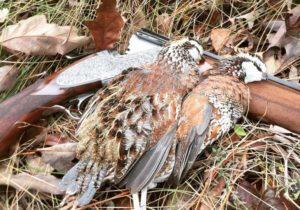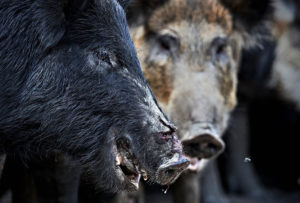The first time you hunt Chukar is for fun...
Chukar hunters have a saying: “The first time you hunt chukar is for fun, and every time after that is for retribution.”
It means you will fail the majority of the time and then relish in the joy of those rare moments of success!
Hunting is more important than shooting when it comes to chukar hunting. The majority of chukar hunting on public land is long journeys across tough, steep terrain with a gun in hand and little real shooting.
To that end, it’s critical to hike smartly, pack minimally, and take in the scenery…
Habitat of Chukar
The Chukar prefers to dwell on drier, rocky, open hillsides with scattered scrub and grass, where it can eat on the leaves and seeds of a variety of grasses, wherever it may be found in the world.
They can be found in the Great Basin and farther north in western Idaho, eastern Oregon, and western Washington in the United States. The Chukar is a large and strong bird that measures 13 to 14 inches in length. The name’s source is a raucous song of “chuk, chuk, chukar, chukar.”
When it’s not mating season, chukars congregate in smaller groups. Chakar likes to run. They do not fly; however, they will fly short distances, mostly down the slope. They stay within a radius of 3 miles.
Because of the tough nature of the hunt, the long season, and the large public lands covered, the Chukar has become a favorite breed to hunt in the western United States.
Although some hunters prefer hauling a 12-gauge shotgun, a 20-gauge shotgun is the most practical choice to bring along.
Chukar Hunting in Idaho
Idaho features some of the best chukar hunting. Chukar prefers sagebrush-covered landscapes, and the majority of the population lives in southern Idaho.
Many people travel from out of state to hunt Chukar in Hells Canyon. You can also find Chukar around Idaho falls. The daily chukar bag limit is eight birds.
Chukar Hunting in Nevada
Chukar hunting season usually lasts from the middle of October to the first week of February. You can read the set of regulations that can be downloaded or purchased at most sporting goods retailers.
Adults pay $38, and children pay $15 for a resident bird hunting license. Nonresident licenses are sold in daily increments of $23 for the first day and $8 for each additional day.
The daily limit for the 2019/2020 season was six chukars per day, with a total possession limit of 18. According to Nevada Magazine, due to strong chukar population numbers, these are the sites to consider for a successful hunt:
Elko County, Humboldt County, Lander County, Lyon County, Mineral County, Pershing County and Churchill County.
Chukar Hunting in Oregon
The lower Deschutes and John Day Rivers, the Snake River and several of its tributaries, the Malheur and Owyhee River drainages, and mountain ranges such as the Steens, Hart, and Trout Creek Mountains are all important chukar habitats in Oregon. Chukars are one of the most difficult birds to hunt in Oregon.
It is vital to have good boots, a water bottle, and enough food and shells to stay out all day. Binoculars come in handy as well. Chukars have the unsettling tendency of sprinting uphill quicker than a hunter can keep up with them, then flying downhill at high speeds.
Hunters quickly learn that approaching from above or along a contour is the best way to get within range.
Chukar Hunting at Battle Mountain
There’s something about the November air in Nevada that makes people want to go hunting. Perhaps it’s a pleasure to spend time in the hills with a beloved bird dog or having a competition with your friends.
Come join other hunters in Battle Mountain, Nevada, for the Annual Battle Mountain Chukar Tournament the first weekend in November for whatever reason. Hunters must check-in between 5 and 9 p.m. on Friday to collect their bags and instructions for bird preparation.
On Saturday, the hunt begins at daybreak, with check-in from 3:15 to 5:15 p.m. All Nevada Department of Wildlife rules and regulations must be obeyed.
Chukar Hunting in California
California has one of the most diverse upland bird populations in the country. And, if you plan ahead and play your cards well, you might be able to bring home multiple species in your game vest on the same day!
In California, for example, there are three separate quail species that overlap in some locations. Can you say mixed game bag with chukar quail nearby?
The Chukar Season in California will begin on October 16 and end on January 30, 2022. You can also find Chukar in the Red Mountain area; however, the area is too popular and has many chukar hunters.
Chukar Hunting in the Mojave Desert
All upland game hunting in the Mojave National Preserve will need non-lead ammunition starting in 2016.
Additional permits and tags may be necessary, as well as a California hunting license. If an NPS park ranger or state game warden asks for your hunting license and tags, please be prepared to show them.
For specific seasons and hours, as well as general information about hunting in the park, download the Mojave National Preserve Hunting Brochure.
Chukar Hunting in Wyoming
Chukars, like pheasants and Hungarian partridges, aren’t native to Wyoming. Chukars are a type of animal that originated in Asia and the Middle East. They’re about the size of a football and as tough as nails.
They make a life in the Bighorn Basin and central Wyoming’s rugged canyon region. They are not grown and released by the Wyoming Game and Fish Department, and they reproduce spontaneously.
Their numbers change according to the amount of snow on the ground. If they can’t locate bare ground in the winter, they starve, and if the spring is too wet and cold, their offspring don’t hatch. It is better to have a look at the latest hunting forecast for Chukar before planning your trip.
Other Popular US Locations for Chukar Hunting
Montana: Montana is one of the top places in the country for hunting Hungarian partridge, a bird that is sometimes confused with Chukar. Montana Blue Grouse Season lasts from September 1 to January 1, 2022.
Washington: Chukar resides in eastern Washington’s more arid, hilly, and mountainous landscapes. It’s safer to hunt with a buddy in case you twist an ankle or become injured and require assistance. Make sure you and your dog have enough water.
East Oregon: Chukars have a large number of habitat options in eastern Oregon. Cheatgrass, an invasive plant species that was well established throughout much of eastern Oregon before the 1950s, is one of Chukar’s most important year-round food sources.
Their natural environment is steep, rocky, and dry, making it unsuitable for building, agriculture, or other commercial uses other than grazing. The lower Deschutes and John Day Rivers, the Snake River and several of its tributaries, the Malheur and Owyhee River drainages, and mountain ranges such as the Steens, Hart, and Trout Creek Mountains are all important chukar habitats in Oregon.
How To Hunt Chukar: Chukar Hunting Strategies
Hiking in the type of terrain you’ll be hunting with a friend, a hand thrower, and some shooting clays is the best practice.
Chukar can be seen near water in the early season, especially deeper down in the canyons. By midseason, they’ll be up on top and on south-facing slopes, where they can warm themselves on dark, sun-absorbing rocks. Look for them among rock bands and sage on the leeward side of ridges when it’s snowing.
You’ll want to hunt silently and be ready for long shots if there’s a light breeze. You’ll get much closer in a strong wind, but you’ll have to shoot quickly before the birds take a flight and fly out of your shooting range.
Hunting dogs: Chukar is found by hunting dogs. When there is an up-canyon wind, which is almost always, place them above the birds. Keep your dog well hydrated as well. Rubber dog boots will preserve the dog’s pads and extend the length of your hunt in basalt country.
Running my pointing dog on the ridges from mid-to late-season until he points a covey is my favorite hunt with a pointing dog. Then I’ll sneak down beneath the dog and stroll uphill to scare the birds away; when I can get Chukar to fly over me instead of downward away from me, my shot percentage increases by a factor of two.
Do not ignore the weight: I know chukar hunters who travel light and cover a lot of ground by wearing spandex leggings and running shoes. Chukar hunting isn’t about appearances; it’s about performance. Leaving your tin-cloth pants and shooting jacket in the truck is a good idea.
About 90% of your hunts will be covered with merino wool underlayers, lightweight brush pants, cross-training hiking boots, gloves, a knit hat, a brimmed cap, and a rain jacket.
Add strong wool gloves and gators for snow drifts if it becomes extremely cold. When you need to take a break, a warm jacket is useful. It is always a good idea to visit a chukar hunting outfitter beforehand.
Which gun should I use? I’ve shot wild Chukar with everything from a.410 to a 12-gauge shotgun, but during the early season, I favor 12-gauge and 16-gauge shotguns with enhanced cylinders and adjusted chokes.
Late in the season, I switch between modified and complete chokes. The swing and follow-through are aided with a 28-inch barrel. My favored load remains the same regardless of the gun: high brass 6 shot.
Finding Chukar’s location: Chukar tends to stick to the same areas as long as the weather remains consistent. Make a mental note or mark it on your GPS when you find a covey, and recall what conditions you found the birds in. You’ll probably find them there for a long time.
Water is a basic necessity. Chukar will most likely be in the region if you can find a water source. This, however, will alter as the seasons shift, with late spring and fall rainstorms and winter snowfall blanketing the ground.
Any rain will drive the birds further away from the primary water supply and hence further away from the grail.
Second, look for cover. Chukar has no chance against nest predators like magpies, ravens, or snakes, as well as predators of young and adult Chukar such bobcats, badgers, mountain lions, snakes, hawks, and falcons. Chukar habitat is also important for protecting Chukar from hunters who chase them down and fire lead shot–or, for Californians, lead-free loads–in the sky.
Strong vegetation, thick grass, sagebrush, and rock outcroppings will provide the majority of the cover. These birds prefer the high hills and high rock locations, where they may sunbathe and glass for predators while laughing (wait until you hear one) at those who walk the uplands in search of the elusive Chukar.
Finally, locate food. We can’t live without it, and Chukar can’t live without it either. Chukar birds are foragers who consume green grass, cheatgrass (that dreaded weed), seeds, thistles, pion pine, sunflower, and even grasshoppers.
This is the crucial trifecta for increasing your chances of spotting wild chickens. Remember, the hound hunt; we’re merely out for vengeance on the devils.
Chukar Partridge Hunting
Chukars are endemic to Asia and Southern Europe, and they prefer dry, rocky terrain with a steep gradient. Although they may now be found throughout the western United States as well as areas of British Columbia and Mexico, the Snake River region of Washington, Oregon, and Idaho offers some of the best chukar hunting.
You can cook Chukar by using recipes. For instance, you can try Roast Chukar Recipe or Spicy Marinated Grilled Chukar Recipe.
Ammunition + Firearms
For chukar hunting, both 20-gauge and 12-gauge weapons are suitable. The 20-gauge has the advantage of being smaller and lighter; however, the larger 12-gauge has the advantage of having more shots in the pattern when trying to strike a fast-flying bird.
Because chukars don’t hold their breath as well as other birds, most shots are in the 30- to 40-yard range or further. Many chukar hunters prefer a modified choke or a modified/full or improved/full combination if they fire a double-barrel.
Outside of waterfowl hunting circles, sling-equipped shotguns aren’t very common, although a chukar hunter might think about it. When climbing up and down the steep terrain where these birds occupy, a retractable shoulder sling can come in helpful.
Chukar, like quail and grey partridge, can be taken down with a light load of big shots. However, the more shot in the load, the more likely it is that a few will hit their target. Longer shots are more common with chukars; thus, a hunter must measure the benefit of a more tiny shot against the enhanced knock-down force of a larger shot at greater distances.
A 14-ounce load of size 5 or 6 shot in a 3-inch 20-gauge or 2 34-inch 12-gauge shells could be a reasonable compromise.
Shooting Practice
Chukars, unlike other upland birds, normally fly downhill when flushed, so when you shot at them, they fall, not rise. You’re more likely to shoot over your first few chukars if you’re used to hunting pheasant, quail, or grouse.
It’s tough to practice dropping shots at a trap range or sporting clays course since a clay bird from a trap is often out of range by the time it starts to drop. Finding a location where you can shoot downhill and having someone throw clay birds for you by hand or with a hand-thrower is one possibility.
When it comes to shooting at the real thing, the best suggestion is to take your time and swing on the bird for an extra second or two to get the hang of downhill shooting.
How To Hunt Chukar Without A Dog
Are you planning to go chukar hunting without a dog? Going without a dog means upland bird hunters will be forced to do double duty–all the effort of a man and his best buddy.
But the truth is that you can take limits of pheasants, Chukar, quail, grouse, and partridge without a pointer or a flusher, something you won’t read about in gun-dog magazines.
You can be even more effective without a four-legged hunting companion in some instances. An excellent bird dog is a natural extension of your own personality. A poorly taught dog, on the other hand, will chase deer and rabbits rather than roosters.
Hard-mouthed hounds will abuse your prized birds as chew toys, bringing mutilated corpses to your hand if they can be found at all.
You’d be sensible to leave Hellhound in his kennel and hunt alone if you had the choice between a bad dog and no dog at all.






No Comments